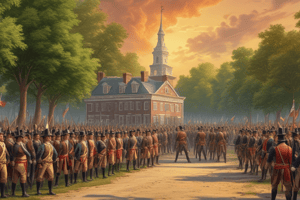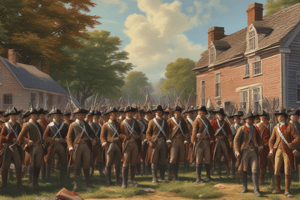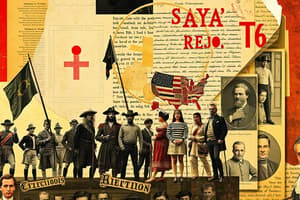Podcast
Questions and Answers
After the Revolutionary War, the USA experienced an economic __________ due to war-time destruction and closed markets.
After the Revolutionary War, the USA experienced an economic __________ due to war-time destruction and closed markets.
downturn
Shays' Rebellion was triggered by which key issue faced by farmers in Massachusetts?
Shays' Rebellion was triggered by which key issue faced by farmers in Massachusetts?
- High tariffs imposed on goods from other states.
- Inability to pay taxes and debts due to poor crop sales. (correct)
- Lack of access to land in the western territories.
- Restrictions on trading with European nations.
By 1786, all 13 original states had outlawed or heavily taxed the importation of enslaved people.
By 1786, all 13 original states had outlawed or heavily taxed the importation of enslaved people.
False (B)
What challenges did free African Americans typically face in the early United States?
What challenges did free African Americans typically face in the early United States?
Name two key figures who advocated for reforming the national government in the late 1780s.
Name two key figures who advocated for reforming the national government in the late 1780s.
What was the primary purpose of the 1787 convention held in Philadelphia?
What was the primary purpose of the 1787 convention held in Philadelphia?
Roger Sherman's proposal, known as the Great Compromise, suggested a ________ legislature with representation in the lower house based on population.
Roger Sherman's proposal, known as the Great Compromise, suggested a ________ legislature with representation in the lower house based on population.
Match the following plans with their features:
Match the following plans with their features:
Flashcards
Economic Depression
Economic Depression
A period of economic decline marked by decreased trade and business activity.
Shays' Rebellion
Shays' Rebellion
Farmers in Massachusetts revolted due to high taxes and debt, led by Daniel Shays.
Anti-Slavery Laws (1776-1786)
Anti-Slavery Laws (1776-1786)
Laws passed by 11 states to prohibit or tax the import of enslaved people.
Racial Discrimination
Racial Discrimination
Signup and view all the flashcards
Constitutional Convention
Constitutional Convention
Signup and view all the flashcards
Virginia Plan
Virginia Plan
Signup and view all the flashcards
New Jersey Plan
New Jersey Plan
Signup and view all the flashcards
Great Compromise
Great Compromise
Signup and view all the flashcards
Study Notes
- Post-Revolutionary War conditions were challenging due to wartime destruction in the South and closed West Indies markets.
- Shays Rebellion in Massachusetts highlighted the crisis, as farmers unable to pay taxes and debts faced land seizure, leading to revolt and attempts to seize weapons.
- The events caused the realization that the USA was in serious trouble.
- People began to question slavery.
- Between 1776 and 1786, 11 states (excluding Georgia) outlawed or taxed the importation of enslaved people.
- Although slavery wasn't a significant labor source in the North, many advocated for its end.
- Free African Americans still faced discrimination, being barred from most schools.
- White individuals did not want to mix and often created separate churches.
- The majority of Americans understood the need for a new form of national government
- James Madison (Virginia), and Alexander Hamilton (New York) were committed to reform.
- A convention was held in May 1787 to address trade issues and fix government problems.
- Fifty-five delegates were in attendance
- No African-Americans or Native-Americans attended.
- The convention was closed to the public, which allowed open discussion without fear of punishment
- Big and small states disagreed over the legislative branch.
- Roger Sherman of Connecticut suggested the Great Compromise.
- The compromise was for a legislature with an upper house where all states got two votes.
- Also specified a lower house with representation based on population.
- For a bill to become a law, both houses must pass it.
- People decided on the Three-Fifths Compromise, where enslaved individuals would count as three-fifths of a person for taxation and representation.
- The North wanted to end the slave trade, but the South didn't want to.
- The slave trade was allowed to continue.
- It was decided that constitution did not need a bill of rights.
- George Mason (Virginia) proposed a bill of rights, but it was not upheld.
- On September 17, 1787, delegates gathered to sign the Constitution.
- 55 men were present, but some refused to sign.
- Later the draft Constitution was sent to the states for approval.
- Nine of the 13 states needed to approve the new law of the land.
Studying That Suits You
Use AI to generate personalized quizzes and flashcards to suit your learning preferences.





